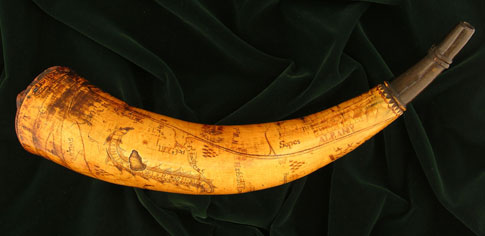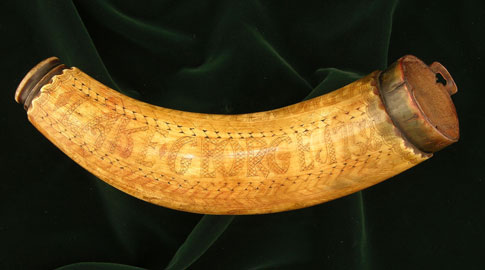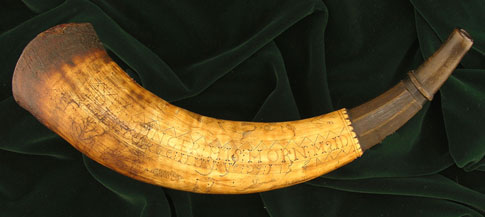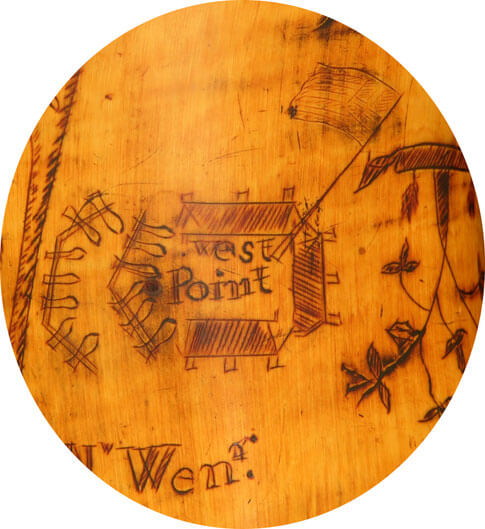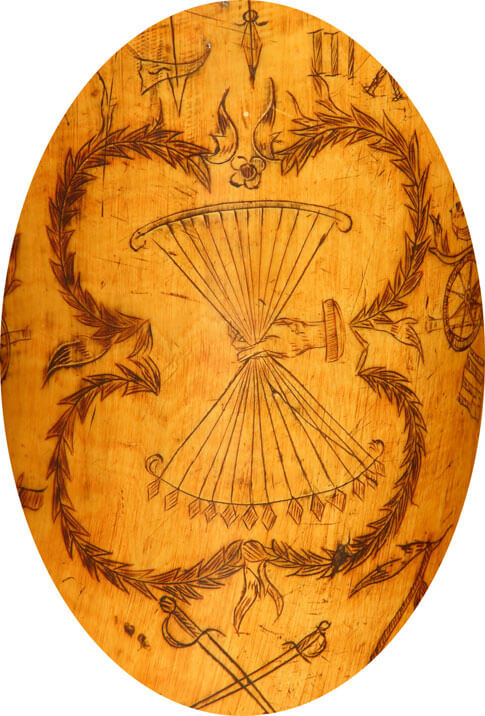This post may contain Amazon Affiliate links for which I may receive compensation.
Written by Tom Grinslade, author of the book “Powder Horns – Documents of History”
Note from Christine: I am very excited to publish the article Tom wrote after I reached out to him with the idea that it seems that most people who own a powder horn are looking for information about its original owner and that it would be very interesting to provide them with tips and references on how to go about such a quest. Below is the article Tom kindly wrote:
Powder horns often have a soldier’s name carved on them. This separates powder horns from other collectibles such as coins, furniture, paintings, jewelry, etc. in that they can be identified as having belonged to a particular individual two hundred years ago. During the eighteenth century when powder horns were greatly used to carry powder for flintlock guns, soldiers signed their powder horns as a means of keeping track of them in camp and when taken to a supply point for filling them. Along with their name, sometimes the date was added and the fort or battle that they were engaged in making them a historic memento in addition to their main function of carrying gunpowder.
This applies mainly to horns of military significance, but also hunting horns often had a person’s name on them that is traceable.
Searching for information identifying the original owner and placing him stationed at a particular fort or serving in a military campaign becomes an enjoyable task for the present owner. The three main sources for information are:
- books with duty rosters and militia lists
- pension lists (mainly limited to Revolutionary War soldiers)
- the internet for additional information
Fortunately, some of the original source books have been reprinted in softcover at a reprint price and are available at Heritage Books, Inc. 100 Railroad Avenue, Suite 104 Westminster, MD 21157-4826, 1-800-876-6103. Also, many of these books are available on the secondary market through Ebay, Abe’s Books, and others. Some suggested titles are listed below:
- Record of Service of Connecticut Men in the, I War of the Revolution, II War of 1812, III Mexican War (Hartford 1880 out of print)
- Rolls of Connecticut Men in the French and Indian War 1755-1757, Vol. I (Heritage)
- Rolls of Connecticut Men in the French and Indian War 1758-1762, Vol. II (Heritage)
- Muster Rolls of New York Provincial Troops 1755-1764 (Heritage)
- Massachusetts Soldiers and Sailors of the Revolutionary War (17 Vol.) also available online
- Massachusetts Officers in the French and Indian Wars 1748-1763 (Edited by Nancy Voye)
- Massachusetts Officers in the French and Indian Wars 1755-1756 (Edited by K. David Goss and David Zarowin)
- Massachusetts Soldiers in the French and Indian Wars 1744-1755 (Edited by Robert E MacKay)
- Massachusetts Militia Companies and Officers in the Lexington Alarm (Edited by Charles E. Hambrick-Stowe and Donna D. Smerlas)
- Rolls and Lists of Connecticut Men in the Revolution 1775-1783 (Heritage)
- Lists and Returns of Connecticut Men in the Revolution 1775-1783 (Heritage)
- Official Register of the Officers and Men of New Jersey in the Revolutionary War, Part 1 William S. Stryker (Heritage)
- Official Register of the Officers and Men of New Jersey in the Revolutionary War, Part 2 William S. Stryker (Heritage)
- Soldiers, Sailors, and Patriots of the Revolutionary War Maine Carleton E.Fisher and Sue G. Fisher compilers
- Records of the Revolutionary War by W. T. R. Saffell (Heritage)
- History of the First New Hampshire Regiment in the War of the Revolution by Frederic Kidder plus New Hampshire at the Battle of Bunker Hill by Henry Moore Baker
- Roster of South Carolina Patriots in the American Revolution by Bobby Gilmer Moss
- A Surname Guide to Massachusetts Town Histories by Phyllis O. Longver and Pauline J. Oesterlin (Heritage)
Pension Lists
- The Pension Lists of 1792-1795 With Other Revolutionary War Pension Records compiled by Murtie June Clark
- The Pension List of 1820 Indexed Edition: A Report of the Names, Rank, and Line, of Every Person Placed On The Pension List (originally 1820)
The Internet
As an example of how the internet can be useful in discovering the history of a soldier’s name on a powder horn, here is the story of the search for Joel Munger’s background. His name appears on two horns one of which was used as a powder horn and the other carried tinder for starting a fire. The search started with the discovery of a sign on Interstate Highway I-95 in Connecticut directing traffic to “Mungertown”, yet a search for a town of that name did not reveal anything. However, in browsing the internet for towns near the sign a reference to an outing in Mungertown was associated with the city of Madison. After calls to the town hall and the library in Madison it was discovered that there was no town called Mungertown today, but because a Munger had settled there in 1651 a very old area of Madison is still referred to as Mungertown. In addition, the local historian knew a part of the Munger family in California who had compiled the Munger family genealogy. That person was able to give the military history of the Joel Munger carved on the two horns as well as his family history. A search for the name of a soldier from the French and Indian War that was begun on the internet reached a successful conclusion.
Fig. 1 Two powder horns with Joel Munger’s name on them. The first horn was for the usual purpose of carrying gun powder and the second a very rare horn used for storing tinder for starting a fire.
Another internet search yielded a great deal of information, but only after the spelling of the soldier’s name on the horn was corrected. The point is that the names on horns are often spelled phonetically or just misspelled by accident. The following horn has the name of John Dewandeler, a Revolutionary War soldier from 1780 on it. Searching on the internet revealed nothing until it was realized that this Dutch name should be spelled with an “a” making it end as “laer”. When this correction was made all kinds of information popped up on the internet. It is important that various spellings should be attempted when searching for information and not to assume that the name on the powder horn was carved there without error.
Fig. 2 The John DeWandelaer’s horn with many figures carved on it, among them the fort at West Point and a cartouche showing a hand grasping thirteen arrows. He was killed and scalped at the battle of Stone Arabia along the Mohawk Trail in 1780 and his powder horn was taken by Chief Scondia of the Oneida Nation as a trophy of war.
Further research on powder horns can be aided by the 27 books and magazine articles listed in the bibliography of the softcover book “Powder Horns – Documents of History” by Tom Grinslade. The book contains 430 pictures in color of 180 powder containers, which are briefly commented on. He can be contacted in Indianapolis by phone at 317-842-0310 or by e-mail at [email protected] to purchase a book for $40.00 plus $5.00 for shipping.

